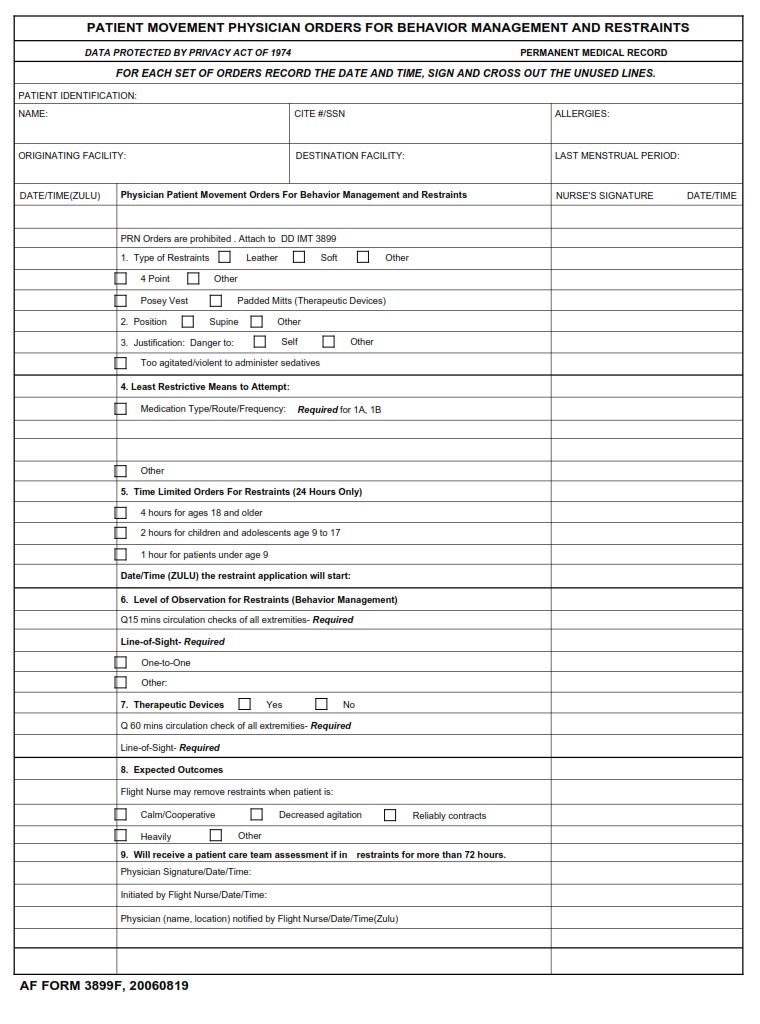AF-FORMS.COM – AF Form 3899F – Patient Movement Physician Orders For Behavior Management And Restraints – Are you curious about the military’s protocols for managing behavior and using restraints during patient movement? Well, buckle up because we’re about to take you on a wild ride through the world of AF Form 3899F – Patient Movement Physician Orders For Behavior Management And Restraints. This fascinating document is like a roadmap for medical professionals, guiding them on how to handle challenging patients and ensure their safety during transportation. Whether it’s dealing with agitated individuals or implementing appropriate restraint techniques, this article will unveil the secrets behind this crucial form and shed light on the military’s approach to patient care.
Brace yourself for an inside look at one of the military’s well-guarded secrets – AF Form 3899F. Behind its unassuming title lies a universe of knowledge that helps military healthcare providers navigate the complex terrain of behavior management and restraints during patient movement. From unruly patients who pose a threat to themselves or others, to finding innovative ways to ensure safe transportation, this article unveils the strategies employed by physicians in these high-stakes situations. So fasten your seatbelt as we dive into this captivating exploration of AF Form 3899F – your ticket to understanding how order is maintained amidst chaos in military healthcare settings.
Download AF Form 3899F – Patient Movement Physician Orders For Behavior Management And Restraints
| Form Number | AF Form 3899F |
| Form Title | Patient Movement Physician Orders For Behavior Management And Restraints |
| Edition Date | 8/19/2006 |
| File Size | 32 KB |
What is an AF Form 3899F?
The AF Form 3899F, Patient Movement Physician Orders for Behavior Management and Restraints, is an essential document used by medical professionals within the Air Force to ensure the safe and appropriate restraint of patients who present a risk to themselves or others. This form plays a critical role in patient care, providing a legal framework for medical staff to follow when handling individuals with behavioral management needs.
What sets the AF Form 3899F apart from other documentation is its ability to provide clear instructions while also considering individualized patient care. The form allows physicians to outline specific behaviors exhibited by the patient that warrant restraint, as well as any underlying medical conditions or considerations that need to be taken into account during transportation or transfer of the individual. It serves as both a record-keeping tool and a communication method between healthcare providers, ensuring continuity of care across different teams or facilities.
By detailing precise methods for behavior management techniques and restraints, the AF Form 3899F helps maintain safety while promoting ethical treatment practices. This form places importance on informed consent and emphasizes the use of the least restrictive measures whenever possible. Medical personnel must carefully assess each situation based on guidelines outlined in this document, allowing them to strike a balance between protecting the rights and autonomy of their patients and safeguarding all parties involved.
Where Can I Find an AF Form 3899F?
If you’re in the medical field or work with patient movements, you may have come across AF Form 3899F – Patient Movement Physician Orders for Behavior Management and Restraints. This form is essential for documenting any restrictions or restraints placed on patients to ensure their safety and the safety of others. But where can you find this form?
The first place to check is your organization’s internal resources, such as intranet websites or shared drives. Many healthcare facilities have standardized forms readily available for staff to access electronically. If your organization has updated its forms recently, there may be an electronic version of AF Form 3899F easily accessible online.
If you are unable to find the form through your organization’s resources, another option is to reach out to colleagues in similar roles who may already have a copy. Networking and seeking advice from others in your professional circle can often save time and effort when it comes to finding specific documents like AF Form 3899F.
Also, consider visiting official military or government websites that provide a comprehensive collection of needed forms. Check sites like the Air Force e-Publishing Portal (www.e-publishing.af.mil) where one can search by form number or title. These portals usually offer downloadable PDF versions that can be saved for future use.
Remember, it is crucial to adhere to proper procedures when using any official documents like AF Form 3899F. Always consult with your organization’s compliance guidelines and follow established protocols when obtaining and submitting these forms.
AF Form 3899F – Patient Movement Physician Orders For Behavior Management And Restraints
The use of behavior management and restraints in patient movement is a complex and highly regulated area. The AF Form 3899F, also known as the Patient Movement Physician Orders for Behavior Management and Restraints, plays a crucial role in ensuring the safety and well-being of both patients and healthcare providers. This form provides physicians with specific guidance on when and how to use restraints effectively while considering the individual needs of each patient.
One of the key aspects emphasized in AF Form 3899F is the concept of least restrictive intervention. It encourages physicians to explore alternative approaches before resorting to physical or chemical restraints. This approach recognizes that every patient is unique, with their own set of circumstances or challenges that may contribute to behavioral issues during their movement. By taking into account these individual factors, healthcare providers can find alternatives such as diversion techniques, verbal interventions, or environmental modifications to manage behavior effectively.
Furthermore, AF Form 3899F highlights the importance of ongoing monitoring and assessment during patient movement. Physicians are required to specify time limitations for using certain interventions and provide regular check-ins to evaluate their effectiveness. This ensures that patients are not unnecessarily subjected to restraint measures beyond what is medically necessary. Additionally, it facilitates effective communication between healthcare providers involved in the care process by outlining key information about the patient’s behavior management plan.
